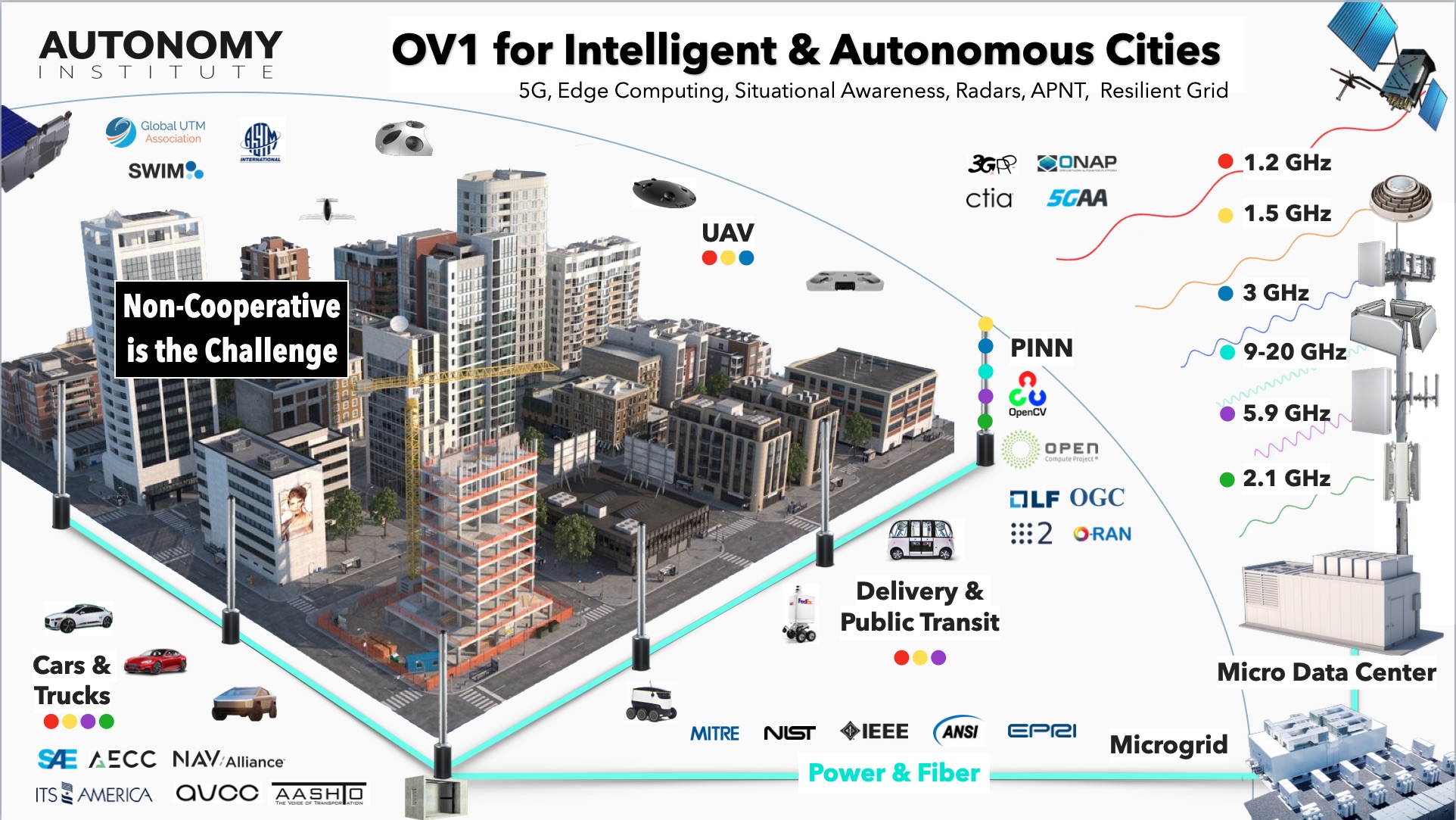Research & Development
The Autonomy Institutes priority is on the development and deployment of autonomous infrastructures. The infrastructure components, architectures, designs, development systems, installation & implementation, operation, deployments, missions, and test & measurement, and performance analysis. The goal is to capture the valuable insights from sensor and telemetry data to validate the robust, secure, and resilient systems.
Initially, early testing has been performed by small Unmanned Aerial Vehicles (UAVs) and small ground based rovers. Necessary infrastructures will be rigorously tested with acquired knowledge that will be shared for the membership’s collective understanding of the system’s capabilities. Research will inform or influence regulatory and transportation systems compliance and readiness. It will be evaluated and made actionable as beneficial information for the company or research group providing the UAVs. The institute anticipates further research will ultimately provide guidance for education and training opportunities for future leaders in the emerging fields of autonomy.
Strategic Objectives
The focused mission of the Autonomy Institute is for the United States to gain global leadership in the development, integration and commercialization of autonomous systems and supporting national infrastructure.
The productivity gains of autonomous systems being deployed into society are massive and will produce 10x gains across many industries. This will be driven by standards and reference architectures.
Intelligent and Autonomous Systems will depend on many Open Standard

Supporting the adoption of key standards to accelerate the “Path to Commerce”
ARCHITECTURE
BLUEPRINTS
STANDARDS

Secure Autonomous System Platforms
Autonomous Systems need to be secure and resilient across the entire platform. Technologies like 5G and Edge computing are at the foundation of autonomy. The silicon chips used for the autopilot, machine learning, sensor payloads, APNT and radio access networks. The software stacks need to be hardened against attacks and illicit intent. A unified deployment of the technology is required to assure a robust system to support commercialization.
The Creation of Autonomous Infrastructure Labs
Autonomous System platforms require a system-of-systems infrastructure to be deployed at a meaningful scale. The Autonomous Infrastructure Labs(AIL) will be persistent test grounds for the advancing technology supporting autonomous systems. These AIL deployments will provide a shared reference architecture that can be deployed across the United States at supporting universities, DoT, DoE, DoD agencies, state agencies, etc.
The Creation of Autonomous Mobility Corridors
As the initial phases of success occur within the Autonomous Infrastructure Labs we will be extending the operational range for autonomous systems. The larger operation zones are called Autonomous Mobility Corridors and are focused on supporting multiple types of autonomous systems within the same region. It may be orchestrated by connecting multiple Autonomous Infrastructure Labs in close proximity together.
Supporting National Security
Security will be a major challenge that will need multiple industries to collaborate to effectively produce a meaningful platform. Autonomous systems will be highly dependent on a robust and secure radio access network(RAN), Edge computing, APNT, Situational Awareness Sensors (i.e. Radars) and many other systems that make up the system-of-systems.
The Deployment of the Autonomous Infrastructure
It is critical to advance the deployment of the supporting infrastructure required by Autonomous Systems. Every game changing transportation platform required new infrastructure. The rail industry required railroads; the automotive industry required state and interstate highways; and the commercial aviation industry required Control towers, radars, transponders and robust communication. Autonomous systems require new infrastructure – low-latency and secure wireless, edge computing, assured-position-navigation-timing (APNT), situational sensors (radars, Lidar, sonar, cameras) and edge ingest.
Secure a Trusted supply-chain
Create a trusted supply-chain for the critical infrastructure to be used by autonomous systems within the United States and other participating countries.
Strengthen our Research and Development Base
It is vital we secure the future technology developments for autonomous systems. The Autonomy Institute will finance specific R&D efforts at United States universities and federal laboratories to generate new technology knowledge and breakthrough science to advance the needs of autonomous systems. The Autonomy Institute would also look to support key research already undergoing development within other advanced research labs. i.e. DARPA Digital RF Battle-space Emulator (BRBE)
Public policy and Legislation for Autonomy
Avigation easements (property rights), technical requirements for deployment, commerce structure, privacy, national security, and interstate commerce being a few. The Autonomy Institute has already developed the foundation for a United States Autonomy Commerce Act.
Path to Commerce is our Core Objective
-
“PATH TO COMMERCE” depends on validating insight to make informed decisions on safety and risk mitigation.
-
Insight requires 10’s of thousands of missions to capture petabytes of data to support validation
-
10s of thousands of missions require s an Active Digital Twin to support a robust simulation and modeling environment. This allows small systems like rovers and drones to be scaled.
-
Deploying 10s of thousands of Rovers/Drones require Technical Risk mitigation strategies
-
Technical Risk mitigation requires deployment ConOps leveraging sensors, physical deployment, sensor fusion at the edge, and other systems to address the challenge of “non-cooperative” traffic. PINNs.
-
Certified ConOps requires Regulatory – policy, legislative, and community support. It is vital to have all parties engaged and supporting the Intelligent, Autonomous, and Electrified Corridors and Grids.
-
Regulatory Support will accelerate the “Path to Commerce” by providing a clear economic impact within communities.
-
We are aligning the initial supporting partners to select the near term list of R&D challenges that must be addressed to take big steps forward.
-
The Autonomy Institute will start to be VERY prescriptive with the knowledge we have developed over the years, but believe is best to be collaborative at the start.
